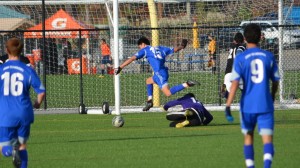Dure: “Development vs. winning” can be taken to extremes in youth soccer
 We’ve seen this scene before, on any U-9 field. The coach asks for a volunteer to play goalkeeper. An enthusiastic kid gets the pinnie and maybe a pair of gloves, then races to the net.
We’ve seen this scene before, on any U-9 field. The coach asks for a volunteer to play goalkeeper. An enthusiastic kid gets the pinnie and maybe a pair of gloves, then races to the net.
Within a few minutes, everyone knows this kid hasn’t been trained in any aspect of playing the position. The keeper drifts wide of the post, leaving an open net for opponents. Attempted punts bounce to attackers a few feet in front of the box. Don’t even ask about goal kicks.
The coach keeps it positive. Don’t worry about the five goals we just conceded. We don’t do any goalkeeper-specific training at this age.
We’re developing players.
Meanwhile, half the players are crying and don’t want to come back to play the next week.
“Development over winning” is a great philosophy. We’ve seen too many coaches who go to the other extreme, yelling themselves hoarse and refusing to let players figure out the game from different positions and perspectives. Like most philosophies, though, it can be taken to absurd lengths.
Even at the higher levels, coaches can go overboard with the “development” mantra. One year at the NSCAA Convention, a head coach from a top Division I men’s college program lamented conceding a goal from a long throw-in, saying he would never work on such contrived things with his own team. The very next English Premier League game I saw featured, you guessed it, a goal from a long throw-in. That college coach must have been developing his players for something above the EPL.
Back on the youth fields, the untrained goalkeeper shanking punts is just one of the manifestations of taking “development” too far. Throw-ins and corner kicks may take a few minutes to set up in each game, with the help of a kindly referee, because players simply have no idea what to do. (You’d think it would help to get kids to watch actual soccer, but I once coached an English kid and devoted Premier League fan whose first throw-in looked like an attempt at the shot put. No guarantees.)
 Sure, basic skills and ball control should be higher priority than set pieces and the finer points of defensive positioning. But would it really ruin a coach’s curriculum to practice throw-in technique for five minutes, or maybe to remind defenders not to take long touches across the face of their own goal? Cheap goals and constant interruptions, like illegal throw-in calls, take away from the value of playing the game.
Sure, basic skills and ball control should be higher priority than set pieces and the finer points of defensive positioning. But would it really ruin a coach’s curriculum to practice throw-in technique for five minutes, or maybe to remind defenders not to take long touches across the face of their own goal? Cheap goals and constant interruptions, like illegal throw-in calls, take away from the value of playing the game.
And U.S. Soccer has stepped up in one of its new mandates, putting a “build-out line” for younger players to be able to bring the ball out of their own end with less pressure. This rule benefits both sides. Defenders learn to build out of the back. Attackers don’t get as many goals that teach them nothing. (As a side benefit, perhaps that’ll cut down on the number of U-11 parents who say, “You know, little Billy used to love soccer. He scored five goals a game …”)
In an ideal U-9 game, kids walk off the field not totally sure of the score. Some think it was 4-4, or maybe 4-3, or did we lose 4-5? That’s because they got so wrapped up in the joy of playing that they lost track of the count. They can’t do that when they know they spend half the game doing incorrect throw-ins or picking the ball out of the net.
So by teaching a few things that seem to fall on the “winning” side of “winning vs. development,” you may actually get kids to play so well that they don’t even know who won.
And the “winner” there is … development!
SOCCERWIRE MARKETPLACE
- The St. James FC Travel Staff Coach - North (Loudoun) & South (Fairfax)
- The St. James FC Girls Academy (GA) Head Coach - 2 teams
- The St James FC Boys Travel Tryouts
- OFFICIAL BAYERN MUNICH SUMMER CAMPS U.S.
- JOIN THE ALLIANCE!
- OFFICIAL FC BARCELONA CAMPS U.S.
- The Cup San Diego - Hosted by Legends FC
- Players Wanted - Undergraduate or Post-graduate
- Head Coach - South Region at The St. James FC
- Travel Coach - North Region at The St. James FC











